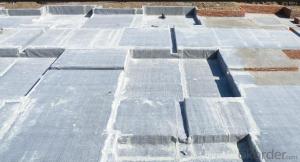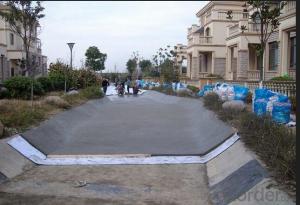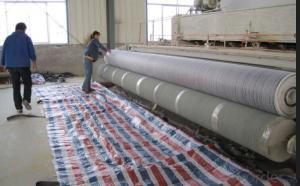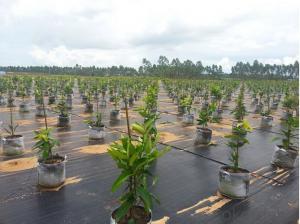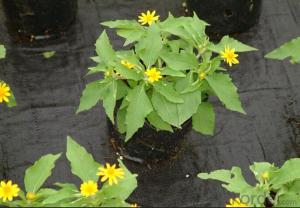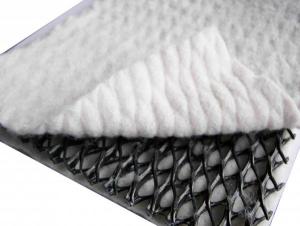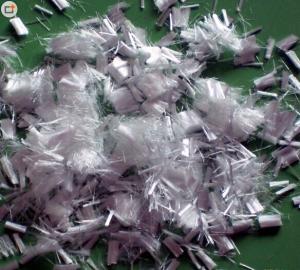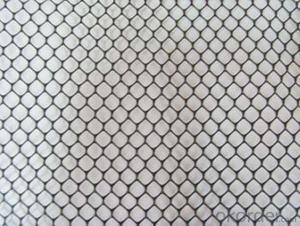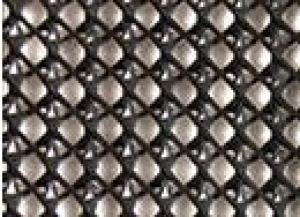Civil Works Material HDPE Geosynthetic Clay Liner(GCL)
- Loading Port:
- Qingdao
- Payment Terms:
- TT OR LC
- Min Order Qty:
- 5000 m²
- Supply Capability:
- 100000 m²/month
OKorder Service Pledge
OKorder Financial Service
You Might Also Like
Civil Works Material HDPE Geosynthetic Clay Liner(GCL)
1,Introduction
Our GCL is composed of 3 layers, the upper layer is nonwoven geotextile, while the lower layer is woven geotextile, natural sodium bentonite fills the gap between geotextile layers. The application with natural sodium bentonite can enlong the using life of construction. Our GCL creates a new green and environmental building material.
We have two kinds of GCL. One is GCL without HDPE layer, the other is HDPE GCL. For GCL, it is widely used in landfill, lagoon, river bottom, basement and so on. For HDPE GCL, it is used in subway, basement, tunnel, underground and projects, salt water area in harsh environment.
2,Features
1. Environment friendly
Our GCL is made of natural sodium bentonite, which contributes to good water proof quality, while causes no pollution to the environment. Its porosity guarantees the breath of biology.
2. Long-lasting waterproof performance
Natural sodium bentonite was formed billions of years ago. Its waterproof performance can last longer than building itself.
3. Easy application
Application of GCL is not constrained by weather. Connection and restore is easy to be finished.
3,Application
· Landfills | · Mud Pits |
· Lagoons | · Canals |
· Bund Lining | · Tank Lining |
· Fish Farm Lining | · Roof Lining |
· Waste Water Pits | · Ponds and Reservoirs |
· Dams | · Floating Covers |
· Vertical Cutoff Walls | · Hydraulic Structure |
· Basement Lining | · Drip Irrigation Ponds |
4,Specification of Geosynthetic Clay Liner(GCL) for anti-seepage
PROPERTIES | Test Method | Typical Value |
BENTONITE PROPERTIES | ||
Bentionite Swell Index | ASTM D 5890 | ≥24ml/2g |
Bentionite Fluid Loss | ASTM D 5891 | ≤18ml |
Finished GCL PROPERTIES | ||
Bentionite Mass/Unit Area | ASTM D 5993 | ≥3.6kg/sq.m |
Peel Strength | ASTM D 6496 | ≥400N/m |
Grab Strength | ASTM D 6768 | ≥6kN/m |
Thickness | ASTM D 5199 | ≥6mm |
Permeability | ASTM D 5084 | ≤5.0×10-11m/sec |
Index Flux | ASTM D 5887 | ≤1.0×10-8m3/m2/sec |
Geotextile PROPERTIES | ||
Non-Woven Geotextile Mass | ASTM D 5261 | ≥200g/sq.m |
Woven Geotextile Mass | ASTM D 5261 | ≥110g/sq.m |
ROLL DIMENSIONS | ||
Width | Normal | 5.8m |
Length | Normal | 30m |
Package | Normal | PE Film |
PROPERTIES | Test Method | Typical Value |
BENTONITE PROPERTIES | ||
Bentionite Swell Index | ASTM D 5890 | ≥24ml/2g |
Bentionite Fluid Loss | ASTM D 5891 | ≤18ml |
Finished GCL PROPERTIES | ||
Bentionite Mass/Unit Area | ASTM D 5993 | ≥3.6kg/sq.m |
Peel Strength | ASTM D 6496 | ≥400N/m |
Grab Strength | ASTM D 6768 | ≥6kN/m |
Thickness | ASTM D 5199 | ≥6mm |
Permeability | ASTM D 5084 | ≤5.0×10-11m/sec |
Index Flux | ASTM D 5887 | ≤1.0×10-8m3/m2/sec |
Geotextile PROPERTIES | ||
Non-Woven Geotextile Mass | ASTM D 5261 | ≥200g/sq.m |
Woven Geotextile Mass | ASTM D 5261 | ≥110g/sq.m |
ROLL DIMENSIONS | ||
Width | Normal | 5.8m |
Length | Normal | 30m |
Package | Normal | PE Film |
FAQ:
How many quantity for one 20'' container?
About 5,000m2, 16rolls
What's your delivery time?
About 15-20days against deposit received
. What's your package?
Per roll with two pieces woven bag
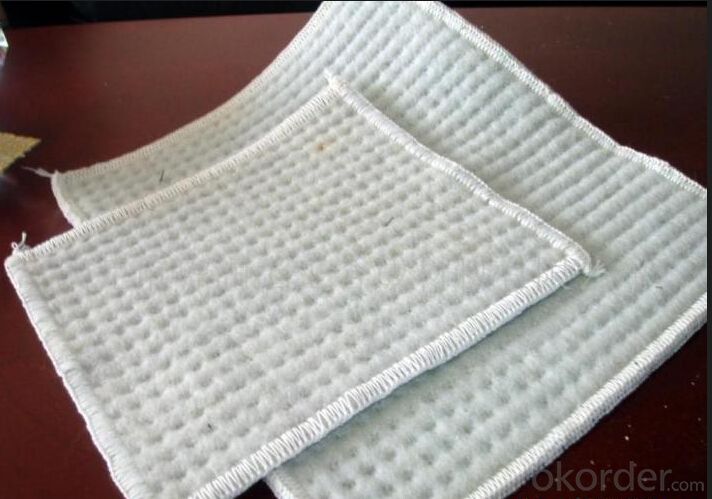
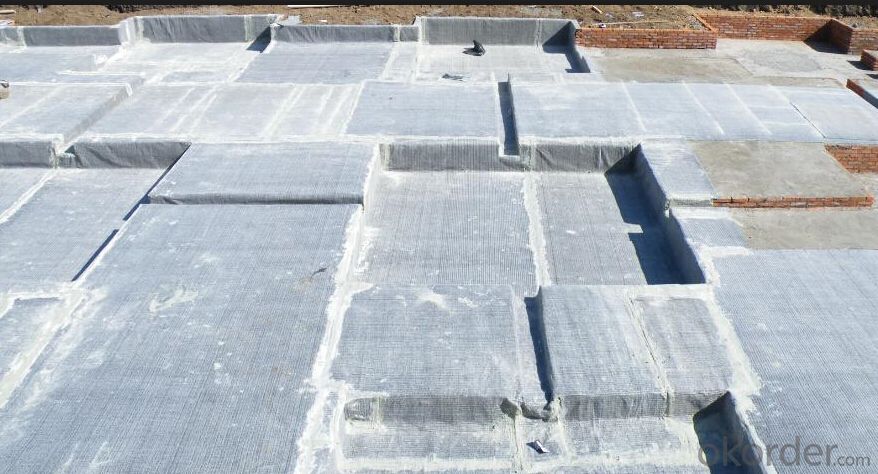
- Q:Material science and civil engineering which is better?
- You can choose according to your hobby and your favorite area, or your own thoughts
- Q:What are the different types of earthwork products?
- Some different types of earthwork products include soil, gravel, sand, crushed stone, clay, and fill dirt. These materials are commonly used in construction and landscaping projects to create foundations, embankments, roads, and drainage systems.
- Q:Can earthwork products be used in slope protection?
- Yes, earthwork products can be used in slope protection. These products, such as geotextiles, geogrids, and erosion control blankets, are specifically designed to stabilize slopes and prevent erosion. They provide reinforcement, filtration, and drainage capabilities, making them ideal for slope protection applications.
- Q:Can earthwork products be used for creating raised planters?
- Yes, earthwork products such as soil, gravel, and rocks can be used for creating raised planters. These materials are commonly used to build the foundation and structure of raised planters, providing a suitable environment for plants to grow.
- Q:Civil engineering materials, the material strength and brittleness to enhance the plastic reduction method
- Plus point plus cross-linking agent
- Q:How do earthwork products help with slope stabilization?
- Earthwork products, such as geogrids and geotextiles, play a crucial role in slope stabilization. These products are designed to reinforce the soil and provide structural support to slopes, preventing erosion and landslides. They help distribute the weight of the soil and reduce the pressure on the slope, increasing its stability. Additionally, these products can improve the drainage and filtration properties of the soil, which further enhances slope stability by reducing water accumulation and preventing soil saturation.
- Q:How do geosynthetic products contribute to soil erosion prevention in agricultural fields?
- Geosynthetic products, such as geotextiles and geomembranes, play a vital role in soil erosion prevention in agricultural fields. These materials are used to reinforce soil structures, control water flow, and protect the soil surface from erosion caused by wind or water. Geotextiles act as a barrier that prevents soil particles from being washed away while allowing water to permeate through. They provide stability and increase soil strength, reducing the likelihood of erosion. Geomembranes can be used as liners for canals or ponds, preventing water seepage and soil erosion. Overall, geosynthetic products offer effective solutions to mitigate soil erosion in agricultural fields and promote sustainable farming practices.
- Q:What are the benefits of using geocells for ground stabilization?
- Geocells provide numerous benefits for ground stabilization. Firstly, they enhance soil confinement, preventing soil erosion and promoting stability. Secondly, they improve load distribution, reducing stress on the ground and preventing uneven settlement. Additionally, geocells facilitate proper drainage, preventing water accumulation and maintaining the integrity of the soil. They are also cost-effective, as they require less material and labor compared to traditional methods. Moreover, geocells are environmentally friendly, as they can be made from recycled materials and are reusable. Overall, using geocells for ground stabilization ensures increased stability, reduced maintenance, and a longer lifespan for infrastructure.
- Q:What are the key considerations when using geotextile tubes for shoreline protection?
- When using geotextile tubes for shoreline protection, some key considerations include the stability of the shoreline, the strength and durability of the geotextile tubes, the appropriate size and placement of the tubes, and the potential impact on the surrounding ecosystem. Additionally, the cost-effectiveness and maintenance requirements should also be taken into account when considering the use of geotextile tubes for shoreline protection.
- Q:Can geomembranes be used for landfill caps?
- Yes, geomembranes can be used for landfill caps. They are often used as a barrier to prevent the leakage of harmful substances from the landfill into the surrounding environment. These impermeable liners can effectively contain the waste and protect the soil and groundwater from contamination.
1. Manufacturer Overview |
|
|---|---|
| Location | |
| Year Established | |
| Annual Output Value | |
| Main Markets | |
| Company Certifications | |
2. Manufacturer Certificates |
|
|---|---|
| a) Certification Name | |
| Range | |
| Reference | |
| Validity Period | |
3. Manufacturer Capability |
|
|---|---|
| a)Trade Capacity | |
| Nearest Port | |
| Export Percentage | |
| No.of Employees in Trade Department | |
| Language Spoken: | |
| b)Factory Information | |
| Factory Size: | |
| No. of Production Lines | |
| Contract Manufacturing | |
| Product Price Range | |
Send your message to us
Civil Works Material HDPE Geosynthetic Clay Liner(GCL)
- Loading Port:
- Qingdao
- Payment Terms:
- TT OR LC
- Min Order Qty:
- 5000 m²
- Supply Capability:
- 100000 m²/month
OKorder Service Pledge
OKorder Financial Service
Similar products
New products
Hot products
Hot Searches
Related keywords
